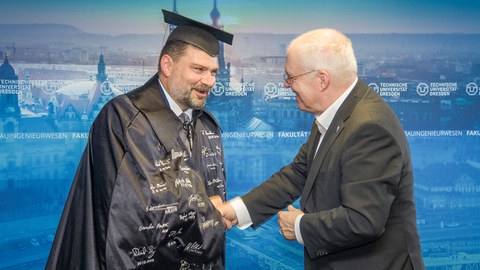Sep 05, 2024
Promotion Matthias Tietze

Matthias Tietze receives congratulations from Prof. Dr. Manfred Curbach
On 03.09.2024, Dipl.-Wirtsch.-Ing. (FH) Matthias Tietze successfully defended his scientific thesis as part of the doctoral procedure with the topic "On the economic value chain of carbon concrete - using the example of double-wall semi-precast construction". In addition to the chair of the doctoral committee, Prof. Dr. Katharina Kleinschrot (TU Dresden), Prof. Dr.-Ing. Dr.-Ing. E.h. Manfred Curbach (TU Dresden) and Prof. Dr. Jens Otto (TU Dresden) were present as reviewers. Prof. Dr. Nizar Abdelkafi (Politecnico Milano-School of management) was connected online. Prof. Dr. Ivo Herle (TU Dresden) was also present as a member of the doctoral committee.
Abstract:
The construction industry has developed little in terms of its division of labor and productivity since the construction of the first large-scale ancient buildings. Since about 1940, this development has been documented across all industrial sectors. Construction, with 6 % productivity growth over the past 80 years, lags far behind automotive at 760 % and agriculture at 1,512 %. However, highly efficient construction production is the basis and necessary to tackle the most pressing problems of our time and to build in a resource-efficient and economical way. To achieve this, new resource-efficient construction methods and lean production processes that meet the new requirements and are unencumbered by entrenched prejudices must be used to unleash their potential.
In the process, lessons can be learned from other industries and the transfer from lean management to lean construction. In order to establish promising construction methods like carbon concrete as a new technology with new methods to give important impulses. Just according to this analogy, this work is also to learn from other areas, transfer methods and transform them for the construction industry.
This work deals with the topic of the economic value chain of carbon concrete. In doing so, after a brief introduction to carbon concrete construction, an economic perspective is taken. Instruments of competitive analysis and market research, in particular multivariate composite measurement, will be introduced and subsequently made usable for analyses of structures in the construction industry. Two sides are considered, once the user side and their requirements as well as the resulting use of certain characteristics. For this purpose, a qualitative collection of data is carried out by means of expert interviews as a basis for the creation of a questionnaire to determine the willingness to pay.
From this, the utility values, e. g. for a wall construction, were determined for selected applications within the framework of an adapted composite measurement. The results were then transferred to a digital tool that can be used to design other building constructions with regard to the user requirements and utility values of the target groups surveyed. From this result, the target costs for each manufacturing step of the value chain were determined for the selected wall construction. The individual manufacturing steps and the properties required by the user were then linked together. Through this linkage, the value chain for a carbon concrete wall component could now be optimized and adapted according to the required user properties. As a result, a competitive carbon concrete value chain is demonstrated and a cost comparison with the reinforced concrete variant is made. It also provides a forecast for the market potential in the application area of automated semi-finished production of carbon reinforced concrete components.
We would like to congratulate Matthias Tietze on completing his doctorate and wish him all the best and every success for the future.
